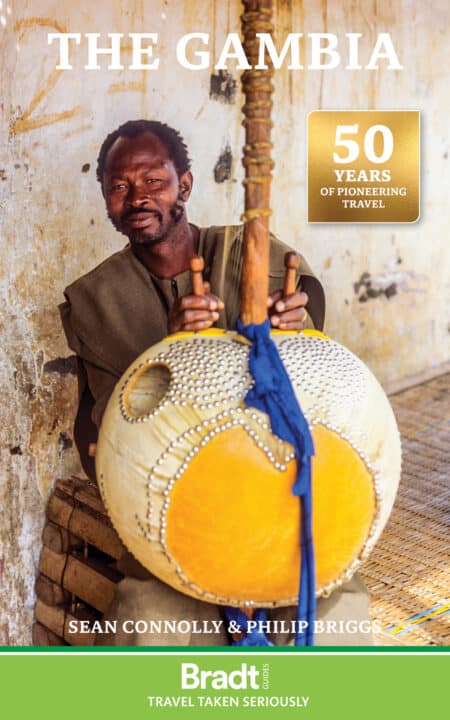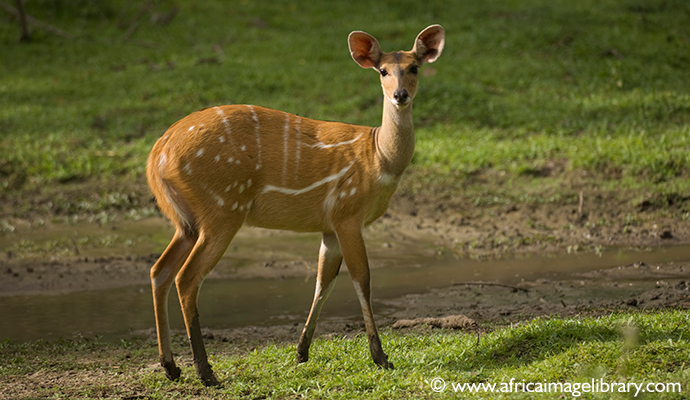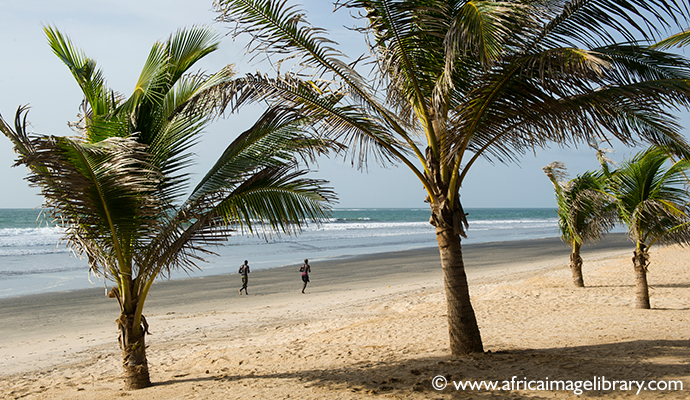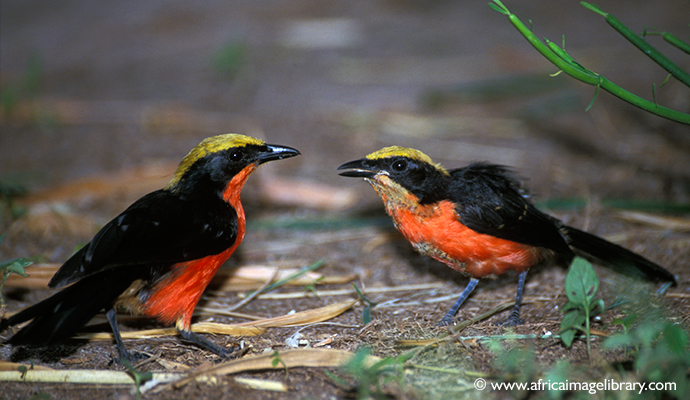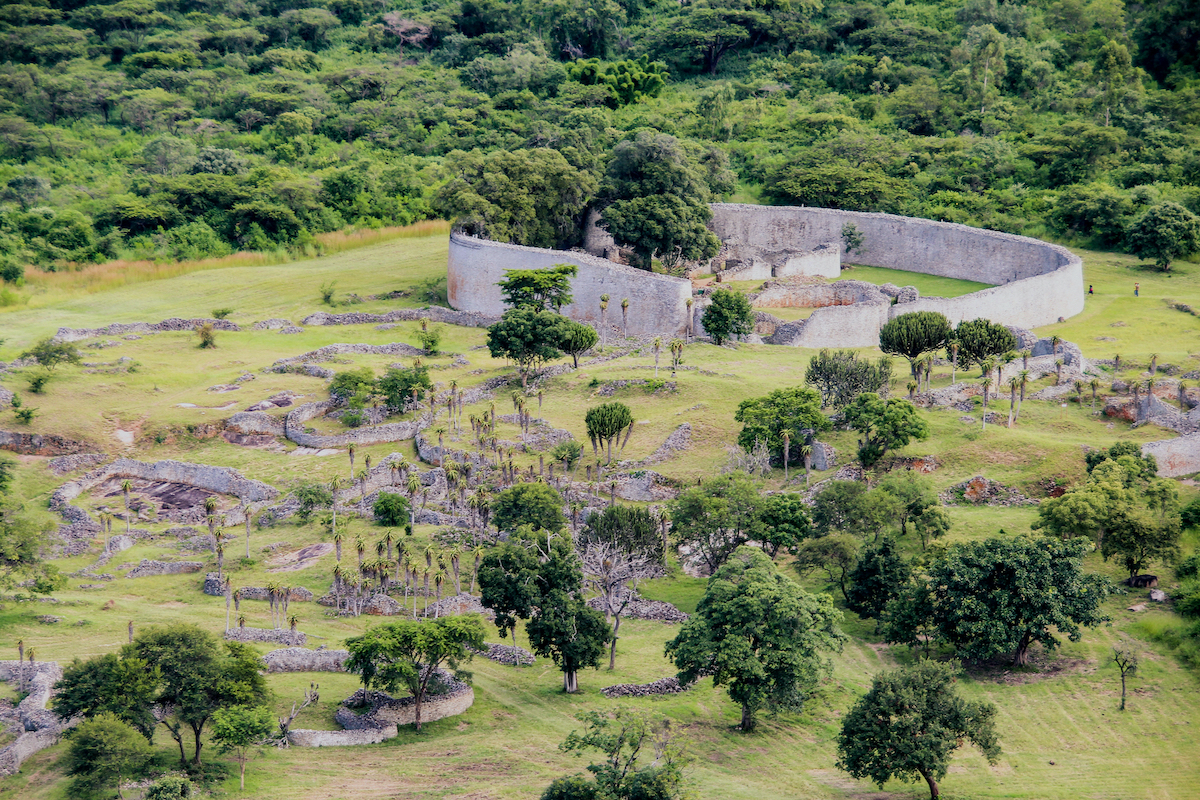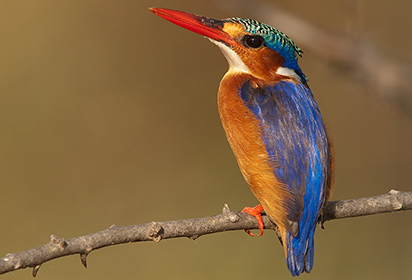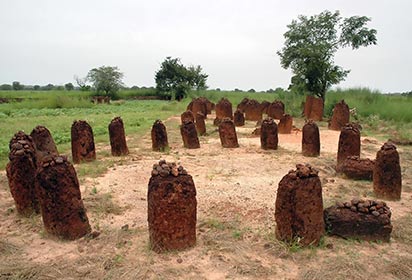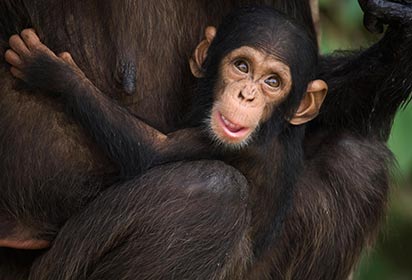Dominated by the contrasting waterscapes of the choppy Atlantic Ocean and more serene River Gambia and literally teeming with tropical birds and monkeys, The Gambia is a beautiful country full of opportunities for adventurous travellers.
Philip Briggs author of The Gambia:The Bradt Guide
The smallest country on mainland Africa, The Gambia is a rather low-key Anglophone nation whose serpentine shape mimics the meandering course of the Gambia River for 300km inland of its tropical Atlantic coastline.
Surrounded on three sides by Senegal, this famously welcoming country is also one of the few in West Africa to boast a genuinely thriving tourist industry, thanks to its proximity to Europe and the plethora of beach resorts – catering to all tastes and budgets – that line the 80km stretch of tropical coastline running from the capital Banjul to the remote southern border.
Although perceptions of The Gambia are dominated by the well-organised coastal resorts, the interior offers rich picking to moderately adventurous travellers. Justifiably popular with birdwatchers, the lush mangrove- and jungle-fringed river is also home to crocodiles, hippos, chimpanzees and a variety of monkeys.
Historic attractions include the mysterious megalithic stone circles at Wassu and Ker Batch, and the fortified James Island and former slave-trading village of Juffereh (to where Alex Haley traced his ancestry in the book and TV programme Roots) – all of which form part of the country’s two UNESCO World Heritage Sites. All in all, this safe, welcoming and decidedly tourist-friendly English-speaking country makes for an ideal short-stay introduction to the unique atmosphere of Africa.
For more information, check out our guide to The Gambia
Food and drink in The Gambia
Greater Banjul must host at least 100 restaurants catering mainly to tourists, and most international cuisines are represented in resort areas such as Kololi, Kotu and Bakau. Standards are high and prices relatively low. The options upriver are generally limited to hotel restaurants and a few local eateries serving a limited and fairly predictable selection of local dishes. Everywhere in the country, except perhaps the main tourist resorts, a varied selection of street food is sold at kiosks, usually close to the market.
Often this consists of sandwiches, made either with airy light French baguettes or with the heavier Gambian tapalapa, and filled with mayonnaise, margarine, chocolate spread or a spicy paste made with black-eyed beans. Evening is when afra bars, which sell a variety of grilled meat including chicken and beef, come into their own. Throughout the day seasonal fresh fruit, roasted peanuts and cashew nuts, Madeira cake and coconut pieces are readily available to snack on.
Many restaurants have Gambian dishes on their menus, although some may require notice for their preparation. This usually comprises rice or millet served with a spicy fish, meat or chicken stew, which comes in a few main types: domoda (groundnut sauce), yassa (stewed or marinated in onion and lemon), and palasas (a spinach sauce thickened with peanut butter). Another popular choice, known elsewhere in West Africa as jollof rice, benachin (literally ‘one pot’) is a spicy risotto-like Wolof dish made with fish, chicken or beef. Also popular is superkanja, a tasty okra soup whose name derives from the Portuguese supa (soup) and Mandinka kanja (okra). Worth trying too are shrimps fried with garlic in the Gambian style, and Lebanese-style shawarmas, comprising thin slices of lamb (or other meats) with salad and hummus in pitta bread.
The usual range of international soft drinks is sold cheaply all over The Gambia, as is the award-winning local lager beer JulBrew. Most restaurants and bars on the coast serve a selection of imported wines and spirits, though this is less common upriver. Despite The Gambia being predominantly Islamic, the vast majority of restaurants serve alcohol, but there are exceptions, particularly in Basse Santa Su. Wanjo is a sweet but refreshing drink made from hibiscus flowers, and ginger and baobab juice are also sometimes available at bars and restaurants. All around the country, you may see men preparing a green tea called attaya, which is full of caffeine, and has a strong bitter taste that becomes more refreshing on the third brew (locals tend to drink it with copious amounts of sugar). The preparation of attaya takes about an hour and is almost a social ceremony, as the men sit around and chat while the pot is brewing.
Health and safety in The Gambia
Health
The Gambia, like most parts of Africa, is home to several tropical diseases unfamiliar to people living in more temperate and sanitary climates. However, with adequate preparation, and a sensible attitude to malaria prevention, the chances of serious mishap are small. To put this in perspective, your greatest concern after malaria should not be the combined exotica of venomous snakes, stampeding wildlife, gun-happy soldiers or the Ebola virus, but something altogether more mundane: a road accident.
Within The Gambia, a range of adequate (but well short of world-class) clinics, hospitals and pharmacies can be found around Banjul, Serekunda and the main resort areas. Most of the larger beach hotels also have their own clinic or a doctor on call. Facilities are far more limited and basic upriver. Wherever you go, however, doctors and pharmacists will generally speak fluent English, and consultation and laboratory fees (in particular malaria tests) are inexpensive by international standards – so if in doubt, seek medical help.
Travel clinics and health information
A full list of current travel clinic websites worldwide is available on ISTM. For other journey preparation information, consult NaTHNac (UK) or CDC (US). Information about various medications may be found on NetDoctor. All advice found online should be used in conjunction with expert advice received prior to or during travel.
Safety
The Gambia is generally a very safe travel destination, certainly in terms of crime and associated issues. It should be pointed out that, as is the case almost anywhere in the world, breaking the law, in particular the usage of illegal drugs (which includes marijuana), could land you in trouble.
Crime
Theft is not a major concern for tourists, but it is worth following a few common-sense rules, as detailed below:
- Most casual thieves operate in busy markets, particularly those in Serekunda and Banjul, as well as in bus stations and the crowded ferry crossings. Keep a close watch on your pockets and possessions in such places, and avoid having valuables or large amounts of money loose in your daypack or pockets.
- Keep all your valuables and the bulk of your money in a hidden money-belt. Never show this money-belt in public. Keep any spare cash you need elsewhere on your person.
- Where the choice exists between carrying valuables on your person or leaving them in a locked room, we would tend to favour the latter option, particularly after dark, but obviously you should use your judgement and be sure the room is absolutely secure. If you do decide to carry large sums of money, or other valuables, with you after dark, then use taxis; don’t walk around.
- Leave any jewellery of financial or sentimental value at home.
- Avoid quiet or deserted places, such as unlit alleys by night, or deserted beaches by daylight, particularly if they lie close to or within a major urban area. When in doubt, take a guide, though preferably one who has been recommended to you by your hotel or by other travellers. Known places where muggers occasionally prey on tourists are the beach going south from Bijilo, the beach going north from Calypso Restaurant at Cape Point, and the beach going towards Banjul from Denton Bridge.
- Car break-ins are an occasional problem in built-up areas. A favourite trick is to slash the rubbers holding the windows in place and to remove the glass to get access. Never leave money or valuables in a car unless someone you trust is guarding it.
- If you are carrying expensive gear such as camcorders, cameras, binoculars or telescopes, then keep them out of sight in a rucksack unless you are actually using them. Be extra careful when using them in out-of-the-way and lonely places.
- When swimming, be very careful about leaving your valuables on the beach, as people often get their things stolen while they are splashing about, having fun in the sea. Leave them in a prominent place and keep a sharp eye on them while you are in the water, or better still leave at least one person with them at all times
If all of this talk of crime is putting you off, bear in mind that violent crime is very rare indeed. You have far more chance of being mugged in New York, London, Berlin, Johannesburg or Sydney than you ever have in Banjul or Bakau. And you are also extremely unlikely to be threatened with a gun of any sort in The Gambia.
If, by some unlucky happenstance, you are robbed in The Gambia, please report it to the police. If you don’t report a crime, how are the police to know about it and to do something to stop it happening again? Remember, too, that if you want to claim off your insurance you will need a police crime number. It may take a little time to write a statement, etc, but it’s worth the effort.
Female travellers
As The Gambia is mainly Muslim, it is appropriate that women travellers, particularly, should dress so as not to cause offence. This is a good idea, not only out of courtesy, but also to avoid the attention of men, which at the coastal resorts can be a big problem. Upcountry you will very rarely have a problem with Gambian men.
Getting hold of tampons or sanitary towels upcountry can be impossible, though it is easy to buy them from any supermarket in the coastal resorts. If you are travelling upcountry it’s best to plan ahead and take a supply with you, remembering that when travelling in the tropics it is common for women to have heavier and more irregular periods than they would normally have at home.
LGBTQ+ travellers
Any act of homosexuality is criminal in The Gambia. Male offenders currently risk a prison term of up to 14 years, female offenders a term of up to five years. None of which means that homosexuality doesn’t exist in The Gambia; only that of necessity it is somewhat clandestine. Also that, setting aside the rights and wrongs of the matter, and at risk of stating the blindingly obvious, this clearly isn’t a destination suited to single travellers in search of anything approximating a gay scene, while homosexual couples who do visit the country should exercise maximum discretion.
Travel and visas in The Gambia
Visas
A valid passport is required, and the expiry date should fall after your scheduled date of arrival in your home country. No visa is required by holders of passports from the UK, or from most member states of the EU, ECOWAS or Commonwealth countries. Other nationalities need a visa, which typically costs around £30 and requires up to five working days to process at any Gambian embassy or consulate, though it may take longer by courier or post. If you are travelling from a country that does not have a Gambian embassy or consulate then you should be able to obtain a visa directly upon landing at Banjul International Airport or at major immigration posts along the border. However, this is not always guaranteed, so safer not to rely on it.
Immigration control at Banjul International Airport will usually stamp your visa or visitors pass for 15 or 21 days, but will grant up to 28 days if you ask. If you want to stay in the country longer, the pass can be extended on a monthly basis for up to three months at the Immigration Department office in central Banjul.
If you are travelling from a country that has yellow fever (most other African countries including Senegal), you may be asked to show a valid yellow fever vaccination certificate, and might theoretically be refused entry if you can’t.
A driving licence from any country, so long as one of the languages used is English, is valid for up to three months. For longer stays, an international driver’s licence is required.
For security reasons, it’s advisable to write up all your important information in a document and email copies to yourself and a few trusted friends or relatives, together with a scan of your passport (which will facilitate getting a quick replacement if it is lost or stolen). Other information you might want to include in this document are your flight details, travel insurance policy details and 24-hour emergency contact number, passport number, details of relatives or friends to be contacted in an emergency, bank and credit-card details, camera and lens serial numbers, etc.
The Gambia maintains an embassy, high commission or consulate in several countries. These include the UK, the US, Senegal, Belgium/EU, as well as Austria, Canada, Ghana, Guinea-Bissau, Ivory Coast, Japan, Nigeria, Portugal, Sierra Leone, Sweden and Switzerland.
Getting there and away
By air
Most UK-based tourists visit The Gambia on a package, including flights and accommodation, with The Gambia Experience or Thomas Cook, and these companies, which run their own scheduled flights from the UK several times weekly, are also the best source of cheap air tickets from the UK.
From 2018, the easiest way to search for flights to The Gambia will be to use Gambia Flights, a new comprehensive flight-comparison site that can show you the cheapest fares available. Using information gathered from a range of sources, you can look in to flight options from any country, city or airport and find prices in several different currencies.
Overland from Europe
To travel overland from Europe, via Morocco, Mauritania and Senegal, is fairly straightforward, provided you have plenty of time and a reliable 4×4 suited to crossing the Sahara. Anybody planning an expedition of this sort is pointed to Siân Pritchard-Jones and Bob Gibbons’s dedicated guidebook Africa Overland.
Getting around
Around Greater Banjul
Getting around the Greater Banjul area, and the rest of the southern coastal belt, is very straightforward. Indeed, if you are staying at one of the resort hotels in Bakau, Kotu or Kololi, almost everything you’re likely to need on a day-to-day basis – beach, restaurants, supermarkets, bars, and banks – will be within easy walking distance of your hotel. And for day excursions further afield, you have the choice of hiring a taxi, renting a bike, using public transport, or joining an organised excursion set up by a local tour operator or registered guide.
Tourist taxis
Two main types of charter taxi operate in Greater Banjul, both on a similar basis to taxi cabs in many Western cities, except that they are unmetered so it is conventional to agree the fare before the journey starts. The more expensive are the specially licensed tourist taxis (usually green with a white diamond on the side) that can be find outside any of the tourist hotels. These are regulated by the Gambia Tourist Authority and should be fully insured. They will run you to any destination, and usually ask a fixed price for a return trip, inclusive of a period of waiting, so may be negotiable for one-way trips or where no waiting is required.
Shared taxis
The preferred option of budget-conscious travellers is shared taxis, which are usually painted bright yellow with green stripes, and tend to be far cheaper than tourist taxis. These unregulated and often uninsured taxis normally ply a set route and pick up passengers along the way for a set fare of usually D8. But they are also quite willing – indeed, usually very eager – to be chartered on a ‘town trip’, which is where one person hires the whole taxi to wherever they want to go for a negotiable price – typically around £2 per 5km, less than half of what a tourist taxi would ask.
Bicycles
A rented bicycle is a good way of getting around the hinterland immediately outside Banjul and the resorts, with the great advantage of letting you see the towns and countryside at your own pace. Do be careful when out riding though, as Gambian drivers often pass dangerously close to bicycles or cut them off. Furthermore, many roads are full of pot-holes or have their edges worn unevenly which can force cyclists into the flow of traffic.
Further afield
Although most visitors to The Gambia never stray far outside the Greater Banjul area, there is a whole country out there to be explored, whether on public transport or on a self-drive basis. Note that there is no rail system in The Gambia, nor any domestic flight network, nor any river transportation (not unless you count the handful of dilapidated ferry services that connect the South and North banks), which means that public transport is all but restricted to the roads.
When to visit The Gambia
When to visit
The peak tourist season, and the most pleasant time to visit in climatic terms, broadly coincides with the northern-hemisphere winter, ie: late October to April. During these dry months, a high quota of cloudless skies and blazing sunshine is practically guaranteed to those seeking to escape colder and more northerly climes. Other advantages of travel between October and April are that it tends to be cooler and more comfortable at night, there are fewer mosquitoes and other biting insects about, and dirt roads upriver are less likely to be impassable. In addition, plenty of scheduled flights run to The Gambia from the UK (and the rest of Europe) between October and April, so it is often possible to pick up cheap last-minute package deals inclusive of flights and accommodation.
Out of season, May and June are also good for independent travel, with the advantage that the coastal resorts will be much quieter. Over July to September, the average monthly rainfall is above 200mm, and even though much of the rain falls overnight (and the storms can be pretty spectacular), these months are probably best avoided. The rainy season also carries a higher risk of contracting malaria, as mosquitoes tend to be abundant, while the hot and humid conditions can be very uncomfortable at night, particularly upriver where air conditioning and fans are a rare luxury.
For birders, the early dry season, from late October to December, is the optimum time to visit. Following the rains, most wetland habitats will be at their best, attracting huge numbers of passage migrants from Europe, while weavers, bishops and other resident species displaying marked seasonal plumage variations tend to be in full breeding colours. Birding remains rewarding throughout the dry season, as a significant proportion of migrants overwinter in The Gambia, but from February onwards seasonal wetlands tend to have dried up, and there is generally less wildlife around, particularly over May into early June. The beginning of the rainy season is the time when life starts to show itself again: butterflies and dragonflies fill the air, lizards and birds take on their breeding colours, and mango trees attract large numbers of straw-coloured fruit bats. Overall, though, watching the birds and other wildlife in the rainy season becomes difficult because the vegetation is so thick.
What to see and do in The Gambia
Bushbuck at the Abuko Nature Reserve © Ariadne Van Zandbergen, Africa Image Library
Abuko Nature Reserve
Abuko Nature Reserve is a popular goal for day trips out of Greater Banjul, particularly with birdwatchers.The most important habitat in Abuko is the rare remnant patch of pristine gallery forest that hems in the small Lamin River and a few associated pools. This is one of the most northerly projections of the Upper Guinean Forest that extends along much of coastal West Africa from southern Senegal Casamance to western Ghana. Away from the river, the vegetation thins out to become Guinea savannah, which is not as rare as the gallery forest, but still supports plenty of wildlife.
Abuko contains a quite remarkable biodiversity for a reserve of its size, with many thousands of species of fungi, plants, trees, insects and other invertebrates living in and beneath the tall leafy forest canopy. Around 50 mammal species have been recorded, most visibly green monkey, red colobus, bushbuck and Maxwell’s duiker. It also supports a varied selection of birds, with some 270 species recorded, and it is perhaps the best site this close to Banjul for forest specialists such as turacos, greenbuls and hornbills. Hides help you to get close to the animals, which are very used to humans and relatively easy to see – indeed, the monkeys in particular virtually ignore human visitors as they go about their daily routines. The least edifying aspect of the reserve is the so-called animal orphanage, a rundown zoo-like set-up that houses a few miserable monkeys and spotted hyenas.
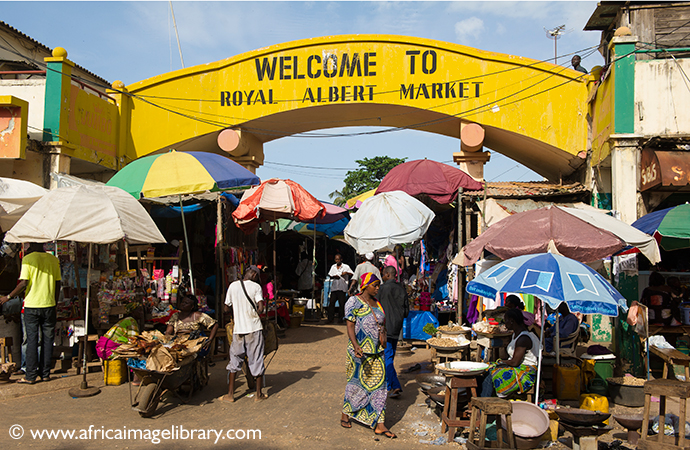
Banjul
Banjul is the least populous capital city on the African mainland, and probably the most compact, with some 35,000 inhabitants confined to an area of around 3km². Occupying the easternmost quarter of a small island that protrudes hooklike into the southern mouth of the River Gambia, Banjul is lapped by open salt water on three sides, while its southwestern shore is dislocated from the mainland by the maze of mangrove-lined creeks that comprise the Tanbi Wetland Reserve. A solitary road, the Banjul–Serekunda Highway, links the capital to the rest of the country, crossing from the island to the mainland at Denton Bridge some 3km west of the city centre.
In its favour, the low-key Gambian capital possesses considerable character. Architecturally, Banjul is a real hodgepodge of old colonial properties, shantytowns and modern office buildings, none more than a few storeys high. And while the overall atmosphere is quite subdued and laidback, certain areas can be very hectic, particularly the stretch of Liberation Avenue that follows the eastern waterfront from Albert Market south to the terminus for the Barra Ferry.
Culturally, Banjul is a melting pot of West African and other cultures. As you walk the streets, you’ll see tall blue-robed Mauritanians, Berbers in white flowing burnouses, Gambian businessmen in bright tie-dye shirts, and local women adorned in a dazzling array of traditional colours. Many shops are owned by Lebanese expats, who, with their dark glasses, often dress and look like members of the Mafia. There are rastas in brightly coloured woollen hats and T-shirts, and office workers dressed in suits and ties or Western-style skirts and blouses. It is amazing, but typical of The Gambia, that so many different races and cultures live alongside each other.
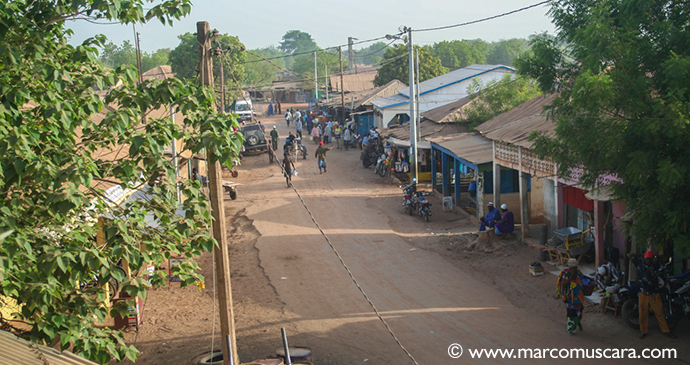
Basse Santa Su
Basse Santa Su, more normally abbreviated to Basse, is set on the South Bank of the River Gambia about 370km inland of Banjul. The administrative capital of Upper River Division, it is also the largest Gambian town east of Farafenni, having witnessed a huge population surge in recent decades, from around 5,000 inhabitants in 1983 to 20,000 today. Basse once must have been a river port of some significance, at least judging by the decaying Victorian buildings that dot its small timeworn waterfront. And it still serves as a transport depot for the local peanut and cotton trade, but these days it is, above all, a market town – indeed, the sprawl of narrow streets that comprises the town centre comes across as one vast chaotic bazaar, spilling over with shops and stalls laden with all manner of imported goods and local wares.
Basse has a strikingly different character from any other Gambian town, thanks to its isolation from the coast and strong cross-border trade links, not only with Senegal, which encloses it on three sides, but also to a lesser extent with Guinea, Mali and Mauritania. From a visitor’s perspective, it feels far less Westernised than any other comparably sized Gambian town – traditional smocks and straw hats are still very much de rigueur here – yet it also has a rather cosmopolitan atmosphere, albeit one that mainly reflects its diversity of West African influences. True, Basse lacks for overt tourist attractions, but for those whose travels in the region are otherwise confined to coastal Gambia, a visit to this busy, noisy, thriving and emphatically African town will be a genuine eye-opener.
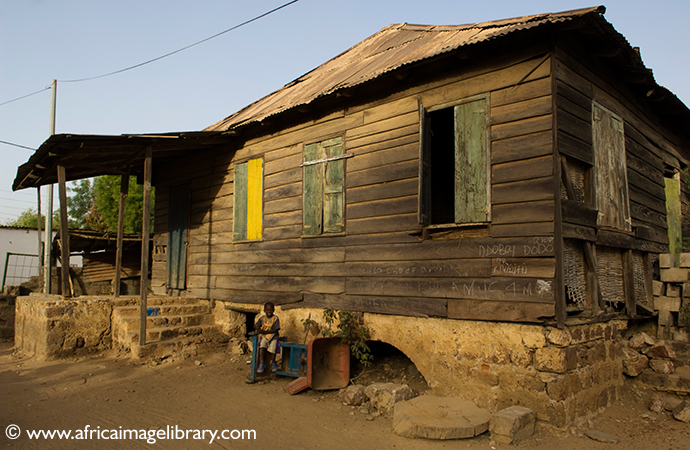
Janjanbureh
Founded by the British in 1823, the port of Janjanbureh (also spelt Janjangbureh), administrative capital of CRD, stands on the North Bank of the 20km² MacCarthy Island about 200km inland of Banjul. Officially known as Georgetown until 1995, it is still often referred to by that name, or as Makati (a bastardisation of MacCarthy). A busy and thriving commercial centre throughout the colonial era, it is now quite a sleepy laid-back place with a population of no more than 4,000.
A few old buildings are dotted around Janjanbureh. Best known among these is the pair of dilapidated waterfront warehouses touted as having slave-trade associations according to the local oral history. The roofless and rather fort-like CFAO Warehouse, immediately east of what is now the ferry slipway, is often referred to as the Slave Market, though in fact it was constructed in the late 19th century and only ever served as a storage place for legitimate goods. However, it is possible that the same site was used as a camp and assembly point by slave traders in the 16th and 17th centuries. On the opposite side of the ferry slipway, the so-called Slave Dungeon – a dank subterranean storeroom adorned with recently added chains and lit by flickering candles to enhance its sinister mood – is also part of a warehouse, built in the late 19th century by the mercantile Maurel & Prom Company. Several less controversial 19th-century architectural landmarks can be seen along Owen Street. A few doors up from the police station, the town’s last intact Creole-style wooden house was originally built by the Jones family, one of the 200 liberated slaves brought to MacCarthy Island in 1832. The plain rectangular Methodist Church, which lies a block further east, is claimed to be the denomination’s oldest church in sub-Saharan Africa, having been inaugurated by the Reverend William Fox in 1835 at a site chosen as a Wesleyan Mission 11 years earlier. The Kankurang Centre is a museum set in a large roundhouse on the outskirts of town showcasing the mask traditions of the various tribes of The Gambia.
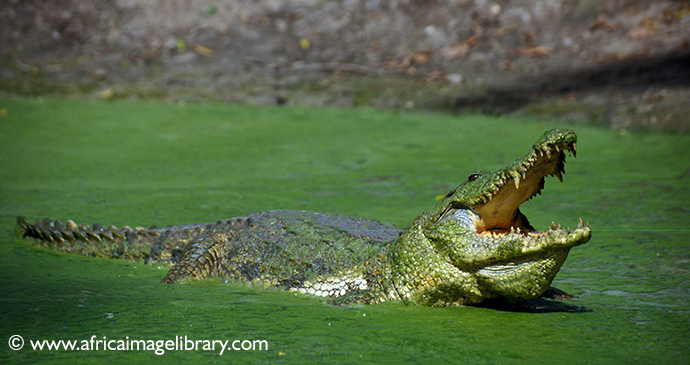
Kachikally Crocodile Pool
The most popular tourist attraction in Bakau is an ancient freshwater pool situated in the heart of the labyrinthine residential suburb of Kachikally (sometimes spelt Kachikali) about 700m south of Atlantic Boulevard. The pool is under the custody of a chiefly clan called Bojang, whose ancestors reputedly settled in the area around 500 years ago. According to oral tradition, shortly after the Bojang arrived in the area, they were visited by the fertility spirit Kachikally in the form of an apparently distraught elderly woman who pretended that her daughter was drowning in the pool. The family did everything they could to assist Kachikally, who rewarded them by entrusting the pool into their care and asking them to populate it with wildlife. A few weeks later, the family captured and released into the pool a pair of crocodiles which are ancestral to the 80 or so individuals that inhabit it today, and act as intermediaries with the spirit Kachikally. During the rainy season, many of the pool’s residents disperse into the surrounding town and countryside, and you hear occasional tales of people waking up to find a young crocodile next to their bed!
Although it is a bit of a tourist trap, the pool is still a popular pilgrimage site for barren women, who come from far and wide to douse themselves in its curative water (any child born after a ritual bathing of this sort is invariably named Kachikally). On a good day you might see more than half-a-dozen crocodiles sunning on the bank, including several 2m-long individuals that are totally habituated to human visitors and even allow themselves to be touched on the back or tail. The largest of these reptilian giants, a 70-year-old 3m-long male named Charlie (reputedly after the first tourist who had the nerve to touch him), seldom makes an appearance these days, though the guides insist he still lives there. The pool itself is often covered in water cabbage, a floating plant that provides shelter for numerous groove-crowned bullfrogs, which form the staple diet of the crocodiles. Be careful close to the water’s edge, as crocodiles that seem docile on terra firma might well attack somebody who falls into their watery home.
At the entrance to Kachikally, an informative little museum includes some interesting displays about the history of Bakau and Gambian involvement in World War II. The museum also displays a good collection of African musical instruments, including the harp-like kora, a 1.5m-long wooden xylophone, and several tall ceremonial drums, plus a selection of traditional masquerade costumes and masks. The leafy pool grounds also host a surprisingly varied birdlife, with the likes of blue-breasted kingfisher, black-headed paradise flycatcher and yellow-throated leaflove likely to be seen flitting about.
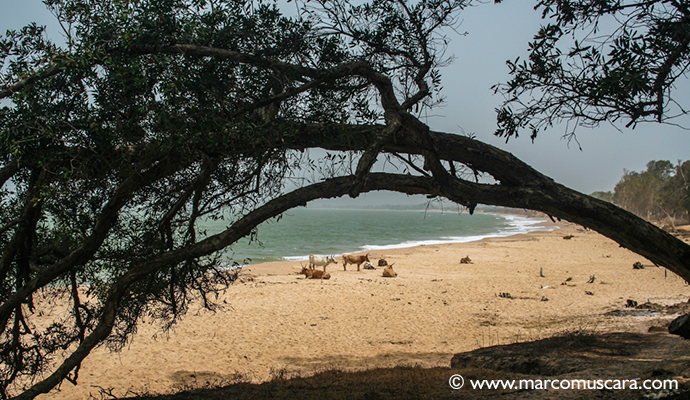
Kartong
Reputedly founded more than 450 years ago, the agreeable border village of Kartong (also spelt Kartung) is one of the oldest in the country, and known throughout the Senegambia region as the site of a sacred pool called Kartong Folonko. The small town’s 5,500 inhabitants are known as Kartonkas, and include a small but distinct community of Balanta immigrants from Guinea-Bissau. The compact town centre lies about 1km inland of the Atlantic coastline and 2km north of the Allahein (or Halahin) River, which flows along the border with Senegal. Kartong is one of the country’s most rewarding ornithological destinations, with a checklist of more than 350 species including several recorded nowhere else in the country, and the area’s reputation in birdwatching circles has grown hugely since the opening of the Kartong Bird Observatory on the western outskirts of town in 2010. Other attractions include the Kartong Folonko, boat trips on the mangrove-lined Allahein River, Lemonfish Art Gallery and the out-of-town Gambian Reptiles Farm, while the lovely stretch of coast north of town is lined with beach camps and eco-lodges. Tourism here is unusually well organised thanks to the efforts of the Kartong Association for Responsible Tourism (KART), the body responsible for the annual Kartong Festival, which has been running since 2006.
Palm trees line Kololi’s beaches © Ariadne Van Zandbergen, Africa Image Library
Kololi
There’s nowhere else in West Africa quite like Kololi. Situated on the Atlantic coastline 15km west of Banjul, this once unremarkable small Gambian village, having first been exposed to tourism in the 1970s, today forms the hub of the country’s booming package resort industry. Here, within an area of about 2km², you’ll find a couple-of-dozen hotels, including such venerable landmarks as the Kairaba and Senegambia, along with a cosmopolitan and seemingly inexhaustible selection of restaurants and bars, and other tourist facilities such as nightclubs, supermarkets, banks and craft markets.
The main touristic focal point in Kololi is the tight cluster of hotels and restaurants that runs west from Senegambia Junction (on Bertil Harding Highway) to the Senegambia Hotel and Kololi Beach Club. This area is most often referred to simply as ‘Senegambia’, or ‘The Strip’, and almost every visitor to The Gambia ends up here at some point, for a meal, or a drink, or a night out. Other important tourist centres are Seaview Boulevard, a few hundred metres north of Senegambia Junction, and a more dispersed group of hotels dotted around Bijilo to the south. The main attraction of this area is emphatically the beach, followed by the busy and wonderfully varied restaurant scene. However, it also boasts one genuinely worthwhile attraction for wildlife enthusiasts in the form of Bijilo Forest Reserve, a patch of bird- and monkey-rich coastal woodland running along the beach between Kololi and Bijilo.
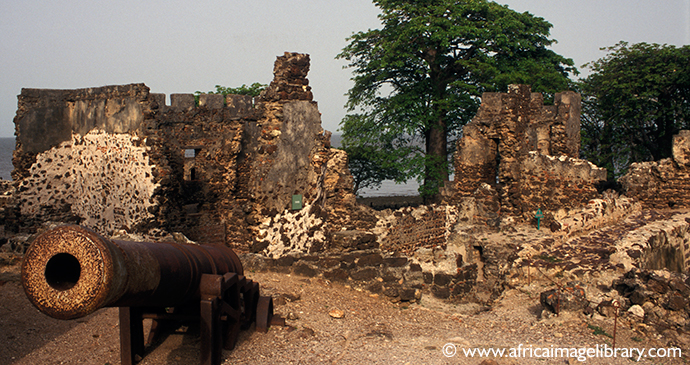
Kunta Kinteh Island and Albreda
Huddled so close together that it’s difficult to tell where one ends and the other begins, the historic twin villages of Albreda and Juffureh (also known as Albadarr and Gillifree, or other variants thereof) sit on the North Bank of the River Gambia about 25km upriver of Barra and Banjul. Together with nearby Kunta Kinteh Island, 3km across the water, these villages played a pivotal role in the slave trade that dominated the economy of the lower River Gambia from the late 15th to the early 19th centuries.
At various times, the Portuguese, British and French all maintained trading posts in the vicinity, while Kunta Kinteh Island was revived as a strategic British naval base in the abolition era. Today, the area is the focal point of a UNESCO World Heritage Site whose seven components include Fort James on Kunta Kinteh Island and four separate buildings in and around Albreda. All in all, it’s a fascinating area, contrasting with the south coast resorts in almost every conceivable way, and well worth visiting, whether you do so independently or as part of a tour.
Makasutu Cultural Forest
An exemplary eco-tourism project, Makasutu Cultural Forest is set alongside the beautiful mangrove-lined Mandina Creek about 5km northeast of Brikama. It is best known perhaps as the site of the exclusive and architecturally innovative Mandina Lodges, but it also offers a selection of worthwhile activities that ensure it’s a regular goal for day trips from the coastal resorts.
Managed in collaboration with the surrounding communities, the reserve was established in 1993 by two well-travelled British enthusiasts, James English and Lawrence Williams, fulfilling a local legend that two white men would save the forest and make it famous (something they learned after the forest opened). It first opened to clients seven years later, since when it has won many awards, including the National Order of The Gambia in 2012. ‘Makasutu’ means ‘sacred and deep forest’ in the local Mandinka language, and the reserve extends over around 10km² of riparian forest, savannah and mangroves, and supports plenty of wildlife, most conspicuously around very habituated 200 Guinea baboons, but also various smaller primates, antelope and carnivores, and aquatic creatures such as crocodile and the occasional West African manatee. The marine and terrestrial birdlife is stunning too.
Makasutu Cultural Forest is highly regarded within The Gambia, not just because of the wildlife found there, but also because it is such a successful blend of different facets. It provides steady employment to more than 100 local people in an area that had seldom seen many visitors in the past: not only workers such as gardeners, drivers, cooks and guides, but also the woodcarvers who utilise the site to sell their wares, and the musicians and dancers who entertain the guests. Visitors, meanwhile, are rewarded with an experience they will long remember and carry home in their hearts. A programme to encourage school visits enables Gambian children to learn about their environment in a fun and positive way. Makasutu, in a nutshell, embodies all that is good about genuine ecotourism.
Yellow-crowned gonolek can be spotted in the park © Ariadne Van Zandbergen, Africa Image Library
Niumi National Park
Effectively a southern extension of Senegal’s vast Parc National de Delta du Saloum, the 50km² Niumi National Park is one of the finest and most accessible of The Gambia’s protected areas, less than an hour’s journey from Banjul, but also one of the most underpublicised. Established in 1986, the park incorporates most of the Gambian coastline north of Barra Point. The dominant feature of the park, its northern tip nudging into Senegal, is narrow, isolated Jinack Island, which is separated from the mainland by the Niji Bolong in the north and shallow mangrove beds (crossable on foot in places when the tide is low) in the south. Jinack is also sometimes known as Paradise or Coconut Island, in reference to the 10km arc of unspoilt sandy beaches along a western coastline whose gradual decline makes for unusually calm swimming conditions. Opposite Jinack, the mainland part of Niumi comprises a large chunk of bush and woodland savannah stretching north
from the village of Kanuma, as well as the magnificent Masarinko Bolong and the escarpment above it.
Jinack Island protects a fair amount of wildlife, and it can be very rewarding for birdwatchers. The main attraction for most visitors, however, is the beach, which is serviced by a handful of small camps but otherwise feels quite gloriously underdeveloped by comparison with most of its counterparts south of the River Gambia. Here, you needn’t fear being disturbed by the music of ghetto blasters, the thunder of traffic, or the inanities of bumsters. A few other things missing here include pollution, discos and supermarkets. In fact the entire island, populated as it is by a scattering of fishermen, farmers and their families, offers a rewarding, tranquil and unaffected glimpse into rural Gambian life, one particularly suited to keen walkers, whose enjoyment will be enhanced by the absence of motor vehicles on Jinack, and the friendly, welcoming vibe exuded by the villagers.
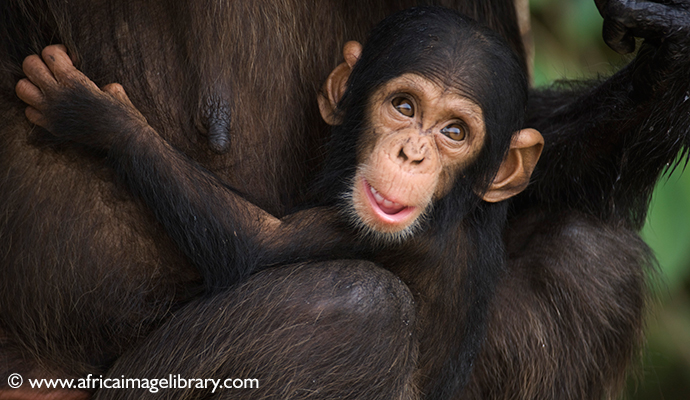
River Gambia National Park
The winding stretch of the River Gambia between Kuntaur and MacCarthy Island has a compelling tropical character, lined as it is with a lush belt of jungle-like riparian forest that evokes the steamy Congo Basin rather than the Sahel. Its centrepiece is the 6km² River Gambia National Park (RGNP), which was gazetted in 1978 to protect Baboon Island and four smaller islets, as well as an adjacent stretch of riverbank, a few kilometres upriver of Kuntaur.
The most publicised attraction of RGNP is the chimpanzees that have been introduced to three of its islands by the Chimpanzee Rehabilitation Project, which also operates an excellent tented camp opposite Baboon Island on the South Bank’s Nyassang Forest Park, a state-owned classified forest jointly managed in collaboration with several local communities. Revenue raised by tourist visits to the CRP goes primarily towards the care and welfare of the chimpanzees, though a percentage is used to help fund government conservation programmes and community development projects.
In addition to chimpanzees, RGNP supports healthy populations of several naturally occurring primates, most conspicuously green monkey, red colobus and Guinea baboon, along with a few-dozen hippos, plenty of crocodiles and monitor lizards, warthogs and manatees, and several small antelope and nocturnal carnivore species. The birdlife is fantastic too: the handsome palmnut vulture, African fish eagle and osprey all nest along the river, the secretive African finfoot inhabits shaded stretches of riverbank, and it’s one of the best places in the country to see forest-associated hornbills, barbets, shrikes, turacos and parrots.
Tourists are forbidden from setting foot on the islands protected within RGNP. This is partly due to the potential danger posed by chimps, who can be quite aggressive toward human intruders. It is also to protect the health of the chimps, which are highly susceptible to human-borne diseases. However, the islands and their inhabitants can be viewed from a boat, ideally with the CRP, which has exclusive access to the channel between Baboon Island and its tented camp. (It can also be arranged through private boat owners in Kuntaur, but this restricts your access to the public channel.) Either way, it is mandatory to be accompanied by a CRP guide on any boat trip running through the park, and an entrance fee of D180 per person is levied.
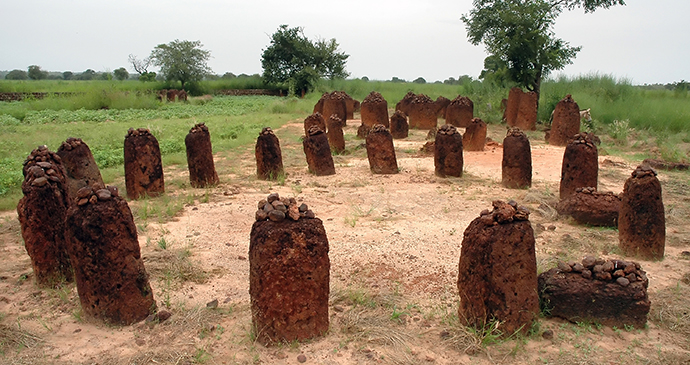
Wassu National Monument
The best-known and most frequently visited of the four sites that comprise the Stone Circles of Senegambia UNESCO World Heritage Site is Wassu National Monument, which boasts the greatest concentration of megaliths anywhere in the country. Altogether, around 200 megaliths, the tallest being about 3m high, are arranged into 11 circles here.
In addition, some 200m east of the main site, the quarry where the stones were carved contains several megaliths that broke in transit or before they had been completed. It contains a well laid-out (albeit rather musty and bat-infested) site museum where an array of models, photographs, paintings and other interpretative material help to bring the history of the stone circles to life. The fenced-off site lies about 500m east of the main North Bank Road, perhaps 10 minutes’ walk and clearly signposted from the junction village of Wassu.
Related books
For more information, see our guide to The Gambia:
Related articles
How many have you visited?
Close to 600 species of bird have been recorded in The Gambia. To be in with the best chance of spotting some of them, you should head to one of these sites.
Author Philip Briggs explores these ancient stone circles, each one reminiscent of a miniature Stonehenge, which form one of Africa’s most enigmatic and intriguing archaeological relicts.
Author Philip Briggs describes the work of The Gambia’s Chimpanzee Rehabilitation Project.
